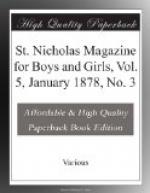Just here a word to the girls about embroidery. In old days, when embroidery was the chief occupation of noble dames and demoiselles, the needle was used as a paint-brush might be, to make a picture of some real thing or some ideal occurrence. For instance: the Bayeux tapestry, worked in the eleventh century by Matilda, wife of William the Conqueror, and her ladies, is a continuous series of pictures, two hundred and fourteen feet long by about two feet wide, which represent scenes in the invasion and conquest of England. Old as it is, the colors are still undimmed and brilliant. Even so lately as the last century, ladies designed their own patterns, and embroidered court dresses and trimmings with flowers and birds copied from nature. But for many years back fancy-work has degenerated into the following of set models, without exercising any “fancy” of one’s own at all. Now the old method is come into fashion again, and it means so much more, and is so vastly more interesting than copying a cut-and-dried pattern from a shop, that we long to set you all to trying your hands at it. For example, if you want a cushion with a group of daisies, gather a handful of fresh ones,—take a bit of linen or china crape, or fine crash or pongee, and, with green and white and gray and gold-colored silks, make a picture of the daisies as they look to you, not using any particular kind of stitch, but employing long ones or short ones, or loose or tight ones, just as comes most easily in giving the effect you want to get. This is much nicer than counting the stitches on a paper pattern and a bit of canvas, and when done, produces a much better effect. Even in winter, a real flower or a fern-spray, by way of model, can always be found in the flower-shops or greenhouses. Practice will stimulate invention and suggest all sorts of devices and ideas. Bits of pretty stuffs will catch your eye as adaptable for use, and oddly tinted silks (the old, faded colors often work in better than fresh ones), patterns on fans, on rice paper, on Japanese pictures—all sorts of things—will serve as material for your fancy. And when your work is done it will be original, and, as such, more valuable and interesting than any shop model, however beautiful in itself, can possibly be.
[Illustration: ANOTHER SCRAP-BAG (SILVER PERFORATED PAPER AND CROCHET-WORK).]
[Illustration: PAPER-CUTTER (NOVELTIES IN FERN-WORK).]
ORIENTAL WORK.
Very gay and quaint effects are produced with this work, which is an adaptation of the well-known Eastern embroideries. Its ground-work is plain cashmere or flannel, red, black or blue, on which small fantastically shaped figures in variously colored velvets or cashmeres are laid and button-holed down with floss silks. All sorts of forms are employed for these figures—stars, crescents, circles, trefoils, shields, palm-leaves, griffins, imps; and little wheels and comets in feather-stitch




